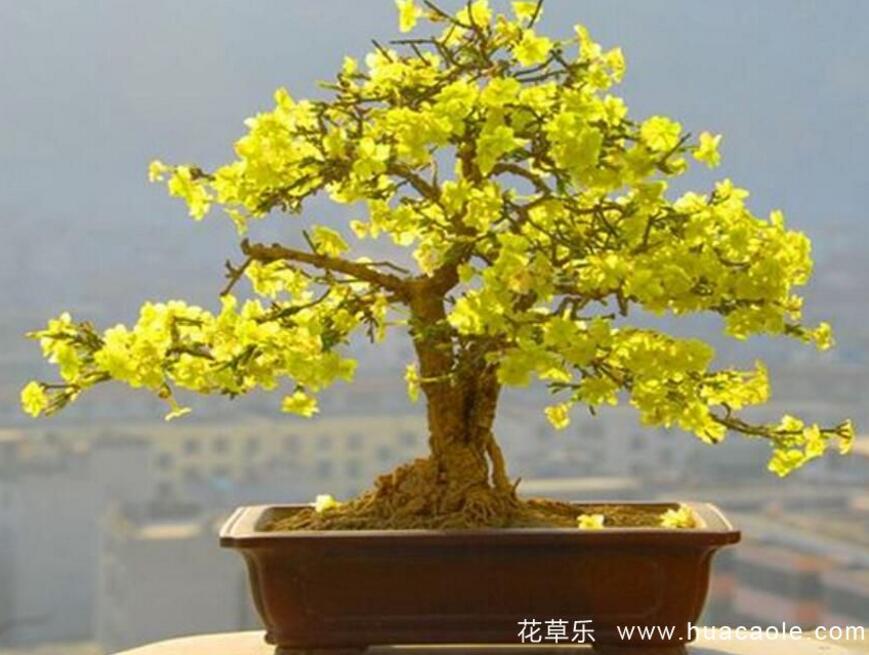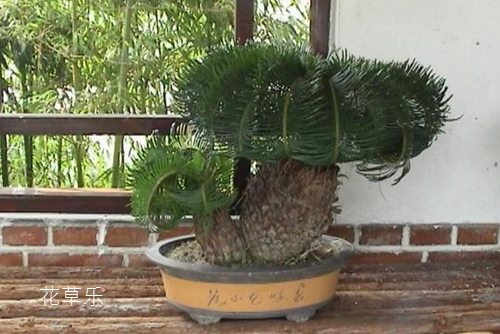How to make a flower of spring flower
Primrose flowers and colors end in the beautiful, extraordinary temperament, and have no fear of cold and majesty, do not choose customs, strong adaptability. Primrose blossoms earliest among the flowers, the tender green branches sway with the wind, and the yellow flowers are in full bloom, as if the golden stars are dotted with branches, which is really lovable. The following pictures of primroses can be reflected. After the flower, it ushered in the spring in full bloom and got its name as the primrose. Primrose is characterized by developed root system, strong tillering ability, resistance to pruning, rapid growth, soft branches, golden green calyx, gorgeous and funny, which is very suitable for making primrose bonsai. Primrose old pile branches vigorous, base hanging roots exposed claws, suitable for making into qu dry type, horizontal dry type, cliff type, water-facing type, wind-blowing type, stone-attached type, overhanging type bonsai shape. How to raise the bonsai of primroses? The following flowers and plants share with you the production and post-maintenance methods of primrose bonsai and the appreciation of primrose pictures.
Introduction to the production of primrose bonsai

First, the production of primrose bonsai 1, the production of bonsai in addition to good pots, the most important thing is to have good stump material
Plants that have grown for many years and have simple and vigorous roots are usually transplanted in early spring or winter. If the stump material is downhill stump, then first of all, it is necessary to protect the root system, maintain the intact root system, remove the disabled and dead root system, straighten the root system, plant the billet first on the ground or plant in the mud basin, prune the plant before planting, cut off the branches and roots that are not needed in shape, and cut the branches that are too long. 2/3 of the main root left behind was buried in the flowerpot culture soil, and 1/3 exposed to the soil as the trunk. After the basin is finished, the basin soil will be pressed and watered. Put it in a shaded place for about 10 days, then put it in a half-cloudy and half-sunny place; maintain it for a week, and then place it in a sunny, well-ventilated and humid place for maintenance. After sprouting, pour thin fat water once a month, pay attention to remove the excess bud head in time, and cut the new branch to a certain thickness. The following year, wash the basin soil with water, so that the trunk buried in the soil slowly reveals the earth and stone. Washing should be carried out several times, and the fibrous root next to the trunk should be cut off in time until the desired effect is achieved, so that the main root will become the trunk of bonsai. After two to three years of pruning and cultivation, a pot of old and colorful bonsai is unfolded in front of us. Root lifting should be carried out step by step and should not be completed at once, otherwise the fine roots of the plant will be exposed too much, causing the stump to sprout back, and even the plant will die in serious cases. After the shape is finalized, the excess branches and leaves should be cut and thinned every year to keep the tree shape unchanged.
2. Design bonsai modeling for the material, and then prune it with pertinence.
Primrose is characterized by developed root system, healthy and simple, smooth trunk cortex, slightly immature, so it is often dried by people's roots, so the bonsai made in this way is highly ornamental. The branches of primrose droop naturally like willows, and the roots have characteristics, so they are suitable for processing into drooping branches and lifting roots.
Bonsai production is that the spring primrose is usually the root of the dew, the trunk is made of horizontal dry type or curved dry type, twigs brushing, unique charm. The shape of the root stem varies from tree to tree, and different forms can be used, such as single dry type, double dry type, oblique dry type, curved dry type, bridge type, root lifting type and so on.
Tree crown mostly adopts hanging branch type, plum pile type and big tree type.
2.1 the drooping branch type is in the shape of a waterfall according to the natural drooping of its branches. The branches are dense and bloom evenly by pruning, which is the most common form.
2.2 the plum pile type will cut off the bent and drooping part of the branch, such as when the newly sprouting lateral branch is about to bend and droop again, it will be cut off again, so that all the branches can be linear and blossom like a sparse horizontal plum blossom.
2.3 the big tree type chooses the plants with twisted and old trunks, main branches and side branches, and prunes the branches into clusters, which looks like a big tree during the growing period, but in fact, the "leaves" of the tree are composed of dense twigs, which is the rarest form because the material is difficult to find.
3. Root culture.
In addition to the oddly shaped old stump down the hill, primrose can also cultivate its own roots. The method of operation is to put more gravel and plant ash in the basin when primrose is on the pot, which will hinder the growth of primrose root system in the process of growth. to form a variety of roots. Plant ash in soil contains potassium fertilizer, which accelerates the growth of root system. In this way, a strong and colorful root system is formed, which lays the foundation for replacing dry bonsai with roots in the future. Yingchun grows for four to five years, and when the main root has the thickness of a thumb, it can be shaped in a pot.
Second, the conservation of primrose bonsai
The main results are as follows: 1. Pruning branches have strong sprouting ability and are resistant to pruning. Generally speaking, a short cut should be made after flowering. Dormant period can also cut off overgrown branches and all kinds of branches that affect the shape of the tree. At the turn of spring and summer, during the peak growth period, proper plucking can be carried out to promote the formation of flower buds and maintain the beauty of the tree. During the growing period, the heart is often removed to promote the thickening of branches and increase branches, which is conducive to modeling, and the branches that affect the shape of trees should be cut off in time to maintain the beauty of bonsai. Other management is basically the same as that of potted primrose.
2. The bonsai of primrose can be reshaped for the first time before flowering and trimmed after the bud in late January. at this time, the shaping is mainly in the overall shape of bonsai, mainly in order to highlight the main body or overall beauty of bonsai when flowering, so it is necessary to keep enough flower buds to bloom next year to reflect the sense of beauty after flowering. The second shaping after flowering, generally according to the last branch of the tree shape, leaving 1 or 2 bud eyes to ensure that the overall tree shape will not be greatly affected after germination. Sprouting branches that are not needed can also be cut off at any time during the growing season.
3. The primrose has a strong germinating power, and it is necessary to pick the heart frequently during the growth period. Generally, it germinates for the first time in spring. When it grows to 3-5 pairs of leaves, leave 1-3 pairs of leaves for a period of time and 2-3 pairs of leaves for a period of time. If the growth is good, you can generally rest assured that you can grow again in July to promote the differentiation of autumn flower buds, but you should pay attention to not all of them. For the places where more ornamental flowers are needed, the hearts are picked in advance, and the others are finally picked in order to prevent the re-germination after heart-picking from consuming nutrients, and the growth can be balanced by picking hearts in batches.
4. Turning the basin to welcome the spring generally turns the basin every two years, and the time should be after the leaves fall in spring or autumn. When turning the basin, it can be combined with pruning the root system, cutting off the withered root and overlong root, in order to facilitate the development of fibrous root. Bean cake crumbs can also be placed at the bottom of the basin as base fertilizer. If you need to pick up the root to welcome the spring, you can lift the root properly when planting, and cover the soil around the root. In the future, with the rain of watering, the root will be naturally exposed.
Time: 2019-04-24 Click:
- Prev

How to raise primroses? Maintenance and management of primrose bonsai
Primrose, dignified and elegant, the flower has a faint fragrance, golden yellow, the outer edge has a red, its flowering period is from February to April, the earliest among the flowers, and then ushered in the flowers to welcome the arrival of spring.
- Next

How should the cycad bonsai shape the leaves? How to dwarf leaves?
Cycad, alias iron tree, banana, palm family cycads, evergreen shrubs. Stem thick and hard as iron, single stem unbranched, large pinnate compound leaf, clustered short stem tip, shaped like wind tail, leaflet linear rigid needle-like, dark green glossy. Because of its unique leaf shape and beautiful plant shape, it is a kind of foliage plant which is very popular with people.
Related
- Fuxing push coffee new agricultural production and marketing class: lack of small-scale processing plants
- Jujube rice field leisure farm deep ploughing Yilan for five years to create a space for organic food and play
- Nongyu Farm-A trial of organic papaya for brave women with advanced technology
- Four points for attention in the prevention and control of diseases and insect pests of edible fungi
- How to add nutrient solution to Edible Fungi
- Is there any good way to control edible fungus mites?
- Open Inoculation Technology of Edible Fungi
- Is there any clever way to use fertilizer for edible fungus in winter?
- What agents are used to kill the pathogens of edible fungi in the mushroom shed?
- Rapid drying of Edible Fungi

